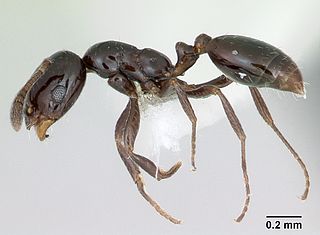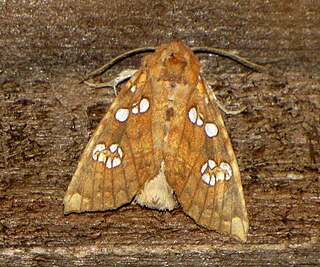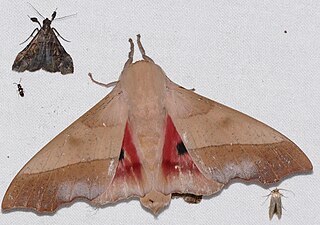
An ectotherm, more commonly referred to as a "cold-bloodedanimal", is an animal in which internal physiological sources of heat, such as blood, are of relatively small or of quite negligible importance in controlling body temperature. Such organisms rely on environmental heat sources, which permit them to operate at very economical metabolic rates.

The fall webworm is a moth in the family Erebidae known principally for its larval stage, which creates the characteristic webbed nests on the tree limbs of a wide variety of hardwoods in the late summer and fall. It is considered a pest but does not harm otherwise healthy trees. It is well known to commercial tree services and arboriculturists. Fall webworms are an invasive species in East Asia.

Arctia is a genus of tiger moths in the family Erebidae. Therein, it belongs to the subtribe Arctiina in the tribe Arctiini in the subfamily Arctiinae. Species are well distributed throughout North America, Palearctic, India, and Sri Lanka.

Euchaetes is a genus of moths in the family Erebidae. It was described by Thaddeus William Harris in 1841.

The little black ant is a species of ant native to North America. It is a shiny black color, the workers about 1 to 2 mm long and the queens 4 to 5 mm long. It is a monomorphic species, with only one caste of worker, and polygyne, meaning a nest may have more than one queen. A colony is usually moderately sized with only a few thousand workers.

Lophocampa is a genus of moths in the family Erebidae. The genus was erected by Thaddeus William Harris in 1841. It contains around 75 species.

Papaipema is a genus of moths of the family Noctuidae. The genus was erected by John B. Smith in 1899.
Chouioia is a genus of endoparasitic wasp of the family Eulophidae. Chouioia cunea is considered an important parasite of the fall webworm in China, where the moth is an invasive species.

Heterocampa is a genus of prominent moths in the family Notodontidae. There are about 18 described species in Heterocampa, found in North, Central, and South America.

Syssphinx is a genus of moths of the family Saturniidae. The genus was erected by Jacob Hübner in 1819.

John Douglas Tothill DSc, CMG, was an English-born entomologist, agriculturalist and civil servant, whose career took him to Canada, Fiji, Uganda and the Sudan. He was the son of Walter Tothill and Frances L. Williams.
Euchaetes cressida is a moth of the family Erebidae. It was described by Harrison Gray Dyar Jr. in 1913. It is found in the US state of Texas and Mexico.
Euchaetes pannycha is a moth of the family Erebidae. It was described by Harrison Gray Dyar Jr. in 1918. It is found in Mexico.
Euchaetes psara is a moth of the family Erebidae. It was described by Harrison Gray Dyar Jr. in 1907. It is found in Mexico.

Euchaetes zella is a moth of the family Erebidae. It was described by Harrison Gray Dyar Jr. in 1903. It is found in the US states of Arizona, California, Nevada, New Mexico, Oklahoma and Texas.
Hyphantria panoezys is a moth of the family Erebidae. It was described by Harrison Gray Dyar Jr. in 1916. It is found in Mexico.
Hyphantria penthetria is a moth of the family Erebidae. It was described by Harrison Gray Dyar Jr. in 1912. It is found in Mexico.

Heterocampinae is a subfamily of prominent moths in the family Notodontidae. There are at least 60 described species of Heterocampinae in North America.

Heteropelma is a genus of parasitoid wasps belonging to the family Ichneumonidae. Species in this genus are around 25 mm in length.













